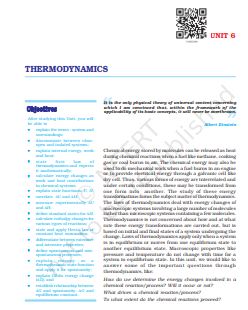‘NCERT Solutions for Class 11 Chemistry Chapter 6‘ PDF Quick download link is given at the bottom of this article. You can see the PDF demo, size of the PDF, page numbers, and direct download Free PDF of ‘Ncert Class 11 Chemistry Chapter 6 Exercise Solution’ using the download button.
NCERT Class 11 Chemistry Textbook Chapter 6 With Answer PDF Free Download

Chapter 6: Thermodynamics
6.1 Thermodynamic Terms
We are interested in chemical reactions and the energy changes accompanying them. For this,
we need to know certain thermodynamic terms. These are discussed below.
6.1.1 The System and the Surroundings
A system in thermodynamics refers to that part of the universe in which observations are
made and the remaining universe constitutes the surroundings.
The surroundings include everything other than the system. The system and the surroundings together constitute the universe.
The universe = The system + The surroundings However, the entire universe other than the system is not affected by the changes taking place in the system.
Therefore, for all practical purposes, the surroundings are that portion of the remaining universe which can interact with the system.
Usually, the region of space in the neighborhood of the system constitutes its surroundings.
For example, if we are studying the reaction between two substances A and B kept in a beaker, the beaker containing the reaction mixture is the system, and the room where the beaker is kept is the surroundings.
Note that the system may be defined by physical boundaries, like a beaker or test tube, or the system may simply be defined by a set of Cartesian coordinates specifying a particular volume in space.
It is necessary to think of the system as separate from the surroundings by some sort of wall which may be real or imaginary.
The wall that separates the system from the surroundings is called a boundary. This is designed to allow us to control and keep track of all movements of matter and energy in or out of the system.
6.1.2 Types of the System
We, further classify the systems according to the movements of matter and energy in or out
of the system.
6.1.3 The State of the System
The system must be described in order to make any useful calculations by specifying
quantitatively each of the properties such as its pressure (p), volume (V), and temperature
(T ) as well as the composition of the system.
We need to describe the system by specifying it before and after the change.
You would recall from your Physics course that the state of a system in mechanics is completely specified at a given instant of time, by the position and velocity of each mass point of the system.
In thermodynamics, a different and much simpler concept of the state of a system is introduced.
It does not need detailed knowledge of the motion of each particle because we deal with the average measurable properties of the system. We specify the state of the system by state functions or state variables.
| Author | NCERT |
| Language | English |
| No. of Pages | 32 |
| PDF Size | 5.1 MB |
| Category | Chemistry |
| Source/Credits | ncert.nic.in |
NCERT Solutions Class 11 Chemistry Chapter 6 Thermodynamics
Q-1: Choose the correct answer. A thermodynamic state function is a quantity
(i) used to determine heat changes
(ii) whose value is independent of the path
(iii) used to determine pressure-volume work
(iv) whose value depends on temperature only
Ans:
(ii) A quantity that is independent of path.
Reason:
Functions like pressure, volume, and temperature depends on the state of the system only and not on the path.
Q-2: For the process to occur under adiabatic conditions, the correct condition is:
(i) ∆T = 0 (ii) ∆p = 0
(iii) q = 0 (iv) w = 0
Ans:
(iii) q = 0
Reason:
For an adiabatic process heat transfer is zero, i.e. q = 0.
Q-3: The enthalpies of all elements in their standard states are:
(i) Unity (ii) Zero
(iii) < 0 (iv) Different for every element
Ans:
(ii) Zero
Q-4: ∆U0 of combustion of methane is – X kJ mol–1. The value of ∆H0 is
(i) = \Delta U^{\Theta }ΔUΘ
(ii) > \Delta U^{\Theta }ΔUΘ
(iii) < \Delta U^{\Theta }ΔUΘ
(iv) 0
Ans:
(iii) < \Delta U^{\Theta }ΔUΘ
Reason:\Delta H^{\Theta } = \Delta U^{\Theta } + \Delta n_{g}RTΔHΘ=ΔUΘ+ΔngRT ; \Delta U^{\Theta }ΔUΘ = – Y kJ mol^{-1}kJmol−1,\Delta H^{\Theta } = ( – Y) + \Delta n_{g}RT \Rightarrow \Delta H^{\Theta } < \Delta U^{\Theta }ΔHΘ=(–Y)+ΔngRT⇒ΔHΘ<ΔUΘ
Q-5: In a process, 701 J of heat is absorbed by a system and 394 J of work is done by the system. What is the change in internal energy for the process?
Ans:
As per Thermodynamics 1st law,\Delta UΔU = q + W(i);\Delta UΔU internal energy = heat
W = work done
W = -594 J (work done by system)
q = +701 J (+ve as heat is absorbed)
Now,\Delta UΔU = 701 + (-594)\Delta UΔU = 307 J
Thermodynamics Textbook With Solutions PDF Free Download
